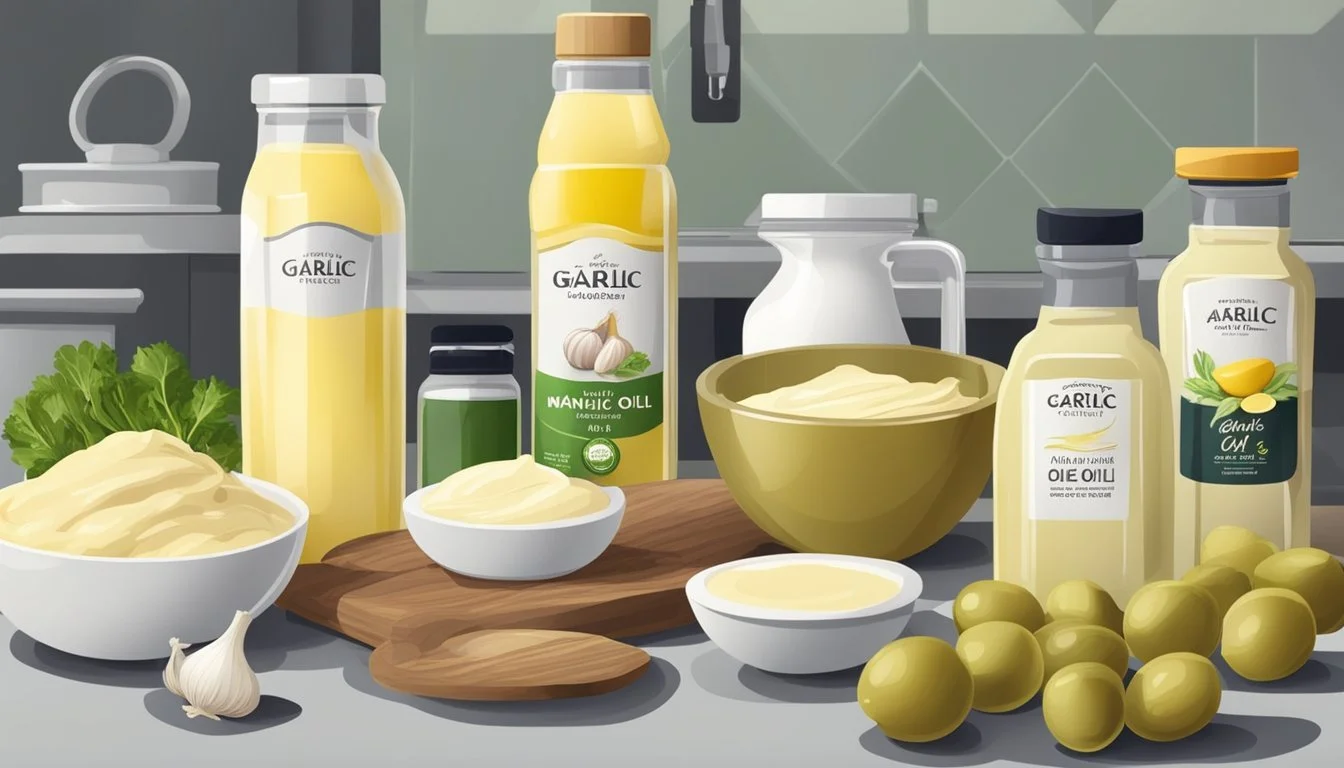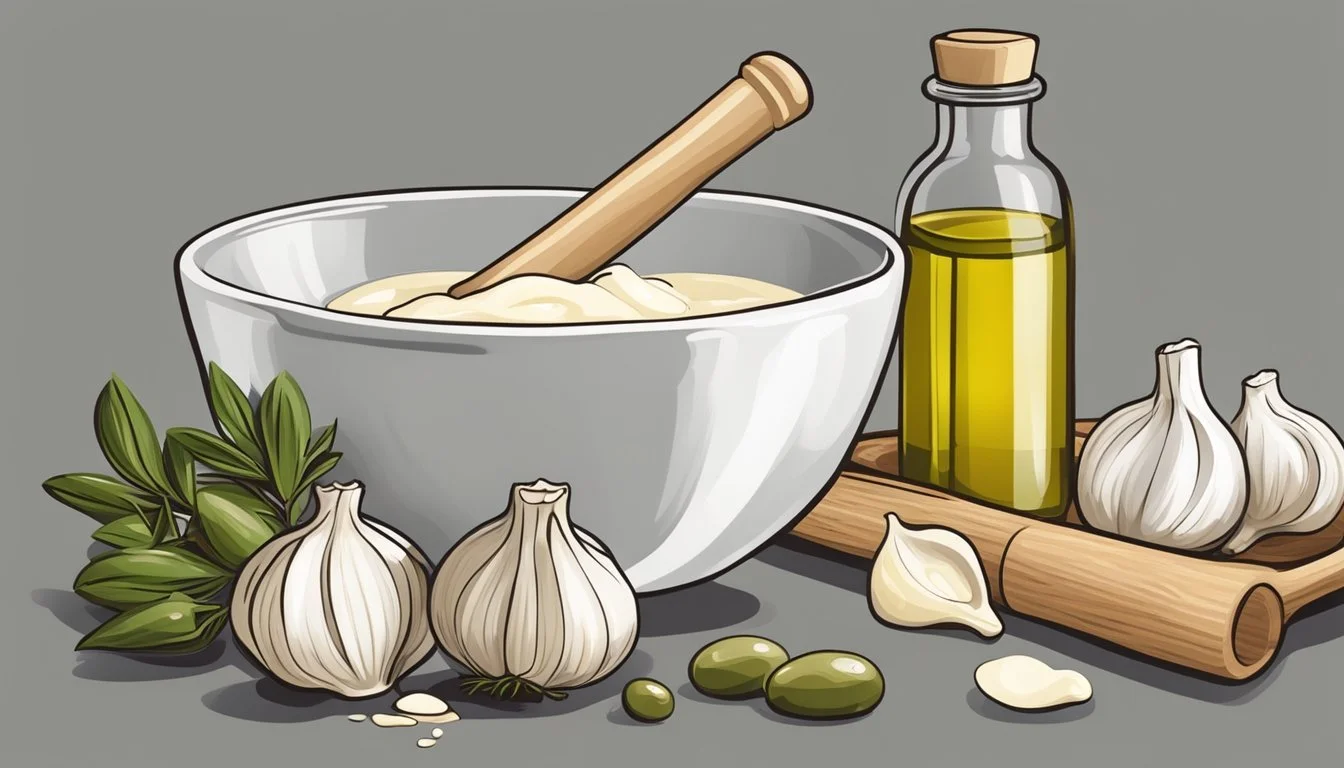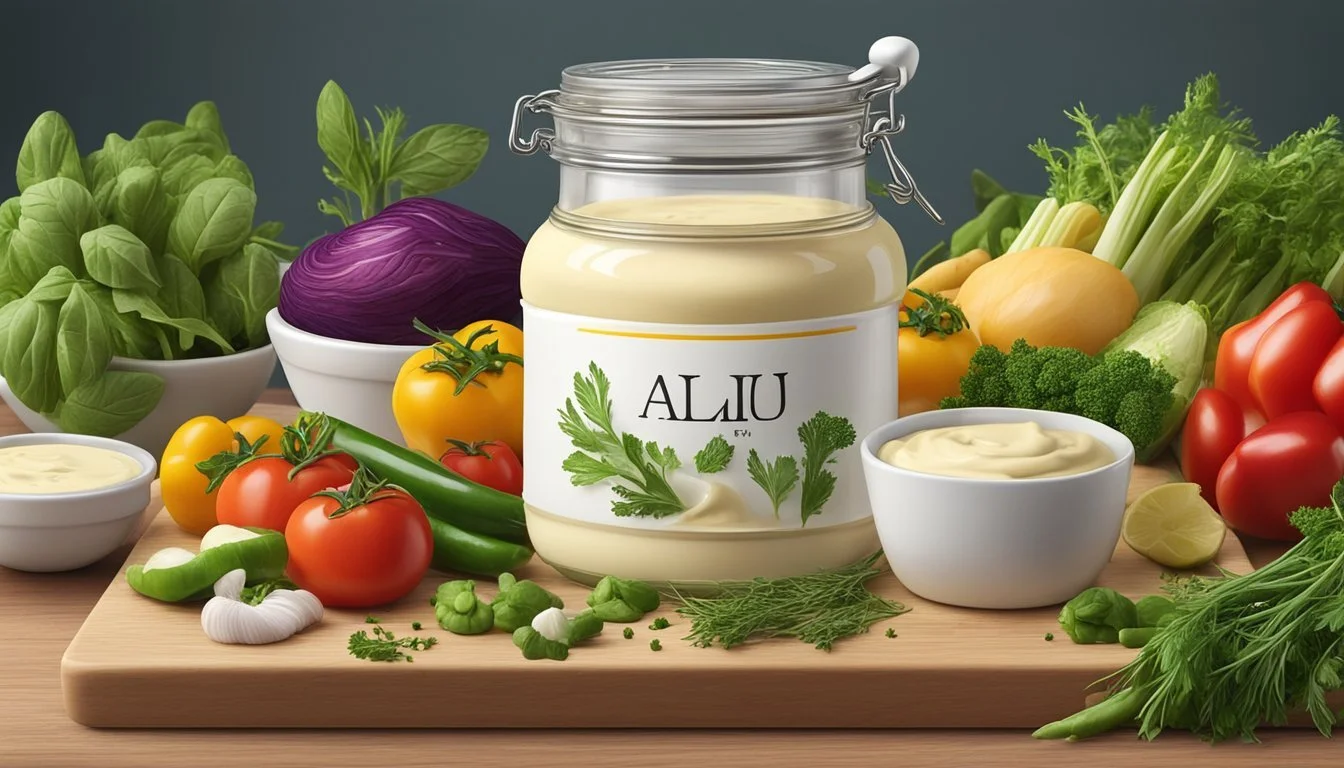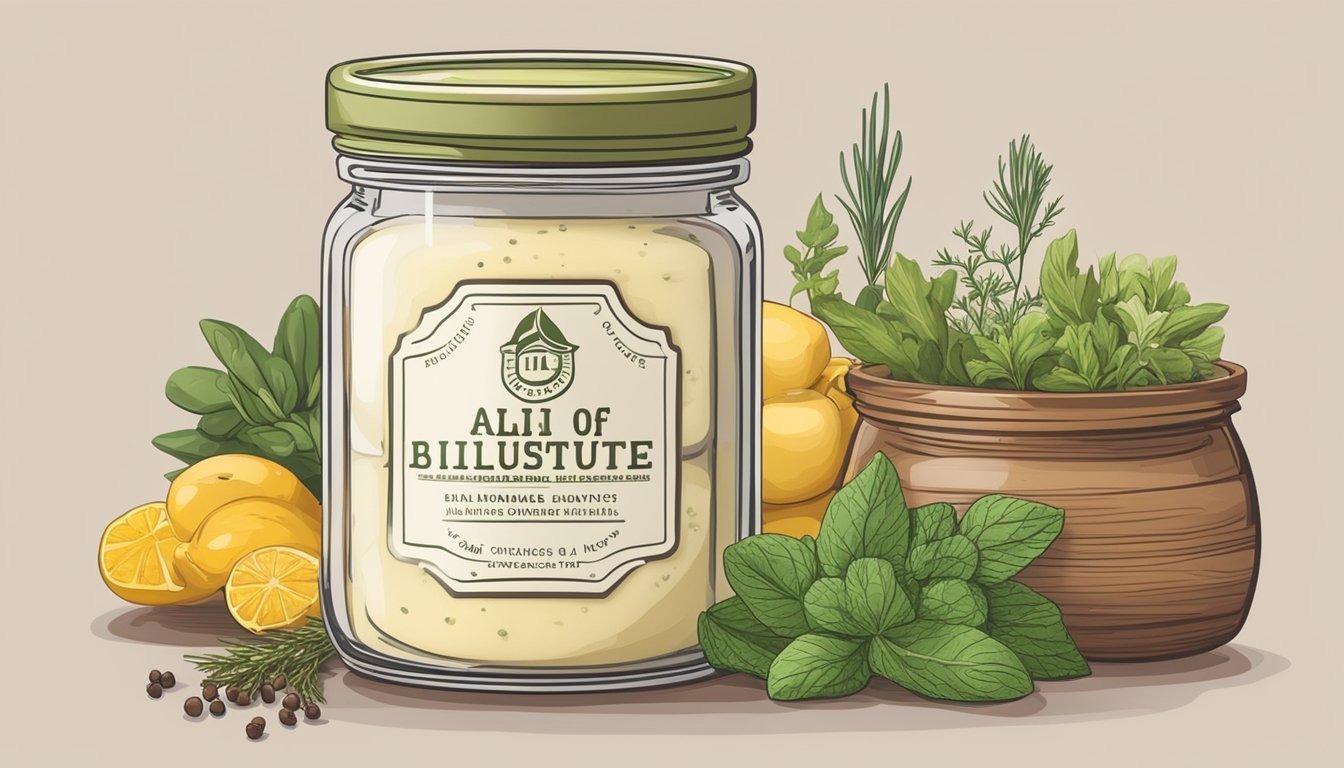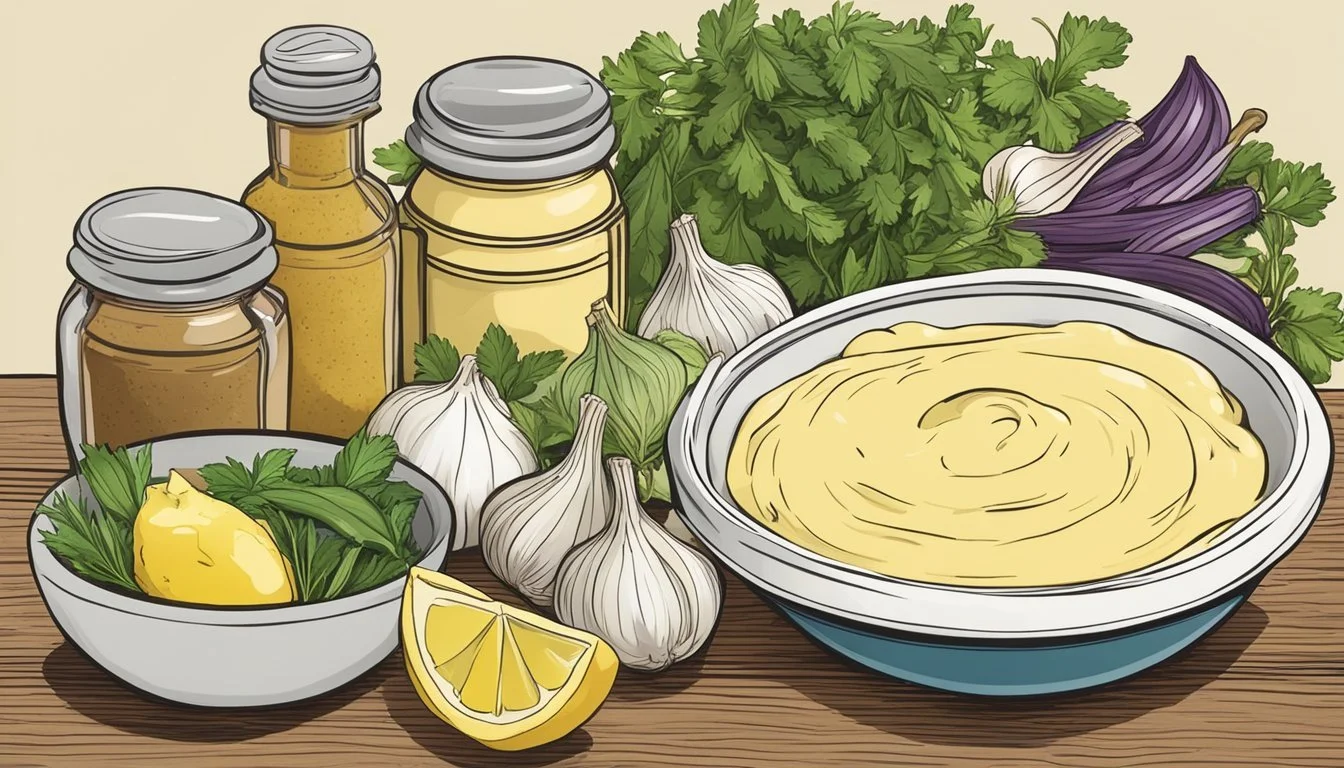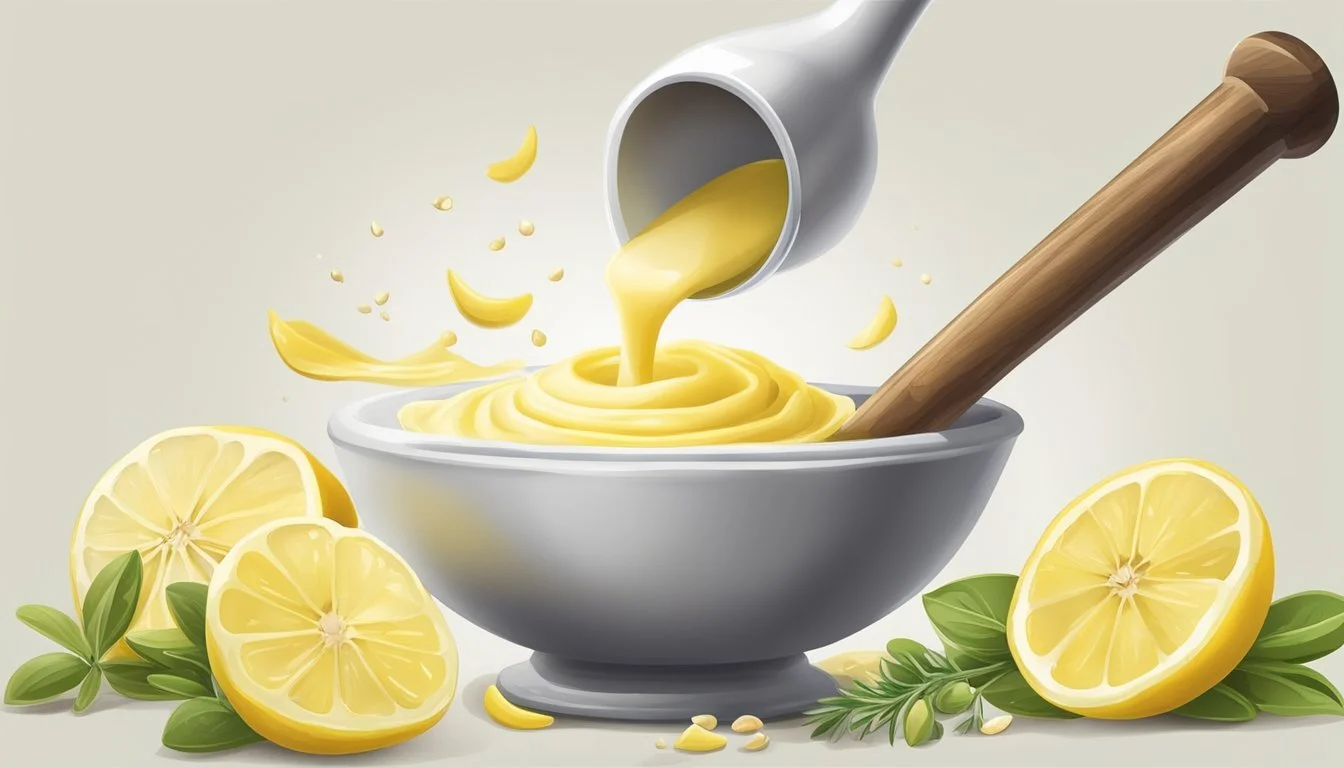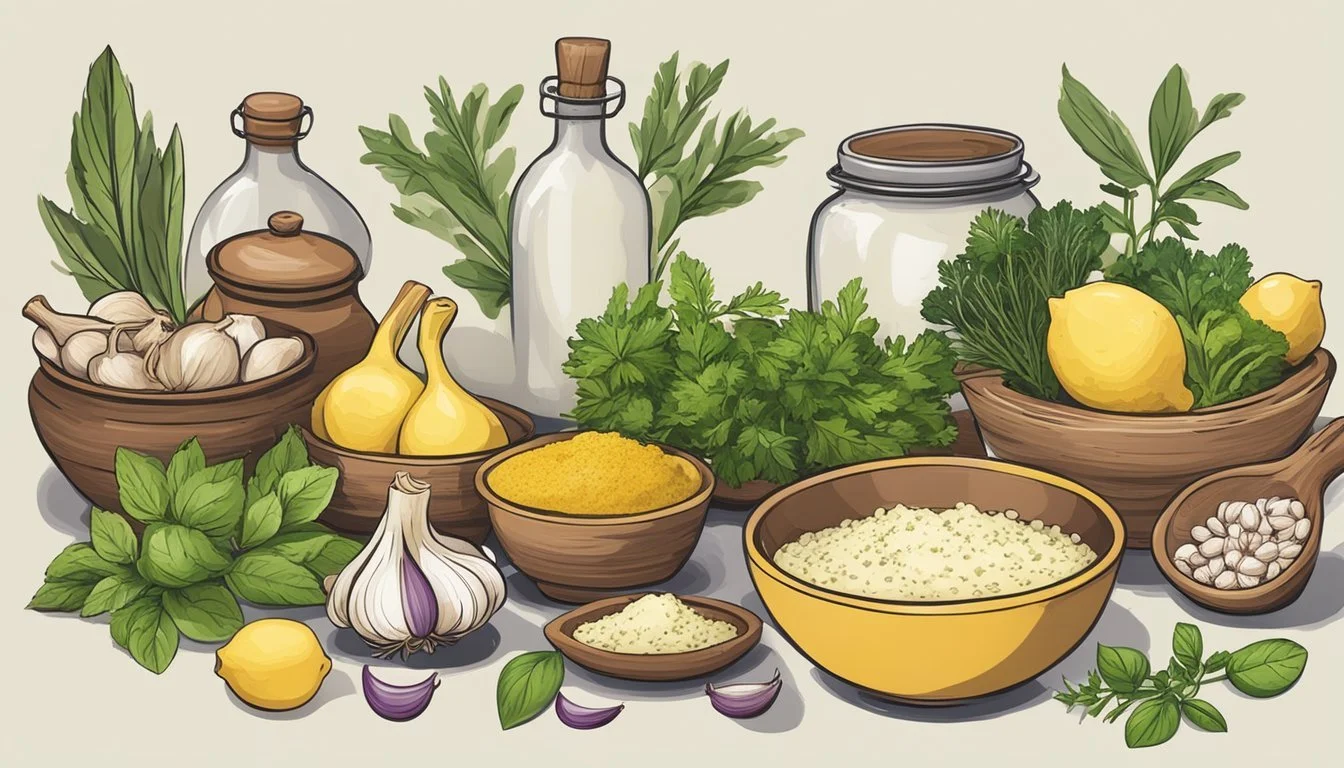Aioli Substitutes
Top Alternatives for Your Recipes
Aioli is a beloved Mediterranean condiment steeped in the culinary traditions of France and Spain. Characterized by its rich, garlicky flavor, this creamy sauce is traditionally made by emulsifying garlic with olive oil. It serves as a versatile accompaniment, enhancing everything from sandwiches and vegetables to meats and seafood. However, not everyone has access to aioli, and sometimes a quick substitute is needed without sacrificing the distinctive taste that aioli brings to dishes.
In the quest for suitable alternatives, there is a range of options available that capture the essence of aioli's flavor while still offering their unique twist. Mayonnaise-based sauces like tartar sauce, rémoulade, and Thousand Island dressing share a similar texture and creaminess. These condiments can be easily tailored by adding garlic to approximate the aioli experience. For those seeking a non-mayonnaise option, Mediterranean dips such as skordalia and tzatziki provide a garlic punch with varying elements of nuttiness or a refreshing cucumber zest.
Other substitutes veer away from traditional Mediterranean flavors while still providing a creamy base that can be adapted with garlic. These include sour cream, cream cheese, Greek yogurt, and even mashed avocado. Each alternative brings a different texture and potential flavor profile that can complement a variety of dishes, allowing the essence of aioli to shine through in both expected and novel ways.
Understanding Aioli and Its Core Ingredients
The essence of aioli lies in its simplicity and the perfection of its core ingredients: garlic, olive oil, and egg yolks.
Traditional Aioli Composition
Traditional aioli is a Mediterranean sauce that relies on the emulsification of three primary ingredients: fresh garlic, quality olive oil, and egg yolks. Each component plays an indispensable role in creating the sauce's signature creamy texture and rich flavor.
The Role of Garlic in Aioli
Garlic is the star in aioli, providing a robust flavor that is both pungent and slightly spicy. It is typically crushed or finely grated to integrate fully into the sauce, allowing the oils released from the garlic to impart their intense aroma and taste.
Egg Yolks: The Basis for Creaminess
Egg yolks are essential for the creamy consistency of aioli. They act as an emulsifier, binding the olive oil and garlic together. The lecithin in egg yolks is a natural emulsifier, which helps prevent the ingredients from separating, resulting in a smooth and velvety texture.
Olive Oil: A Key Component for Texture
Olive oil gives aioli its smooth and luxurious mouthfeel. The type of olive oil used can affect the flavor profile, with extra-virgin olive oil adding a fruity, peppery note. Its role is also functional; when slowly drizzled and whisked into the mixture of garlic and egg yolks, it creates a stable emulsion that defines aioli's characteristic body.
Common Aioli Substitutes
When looking for aioli substitutes, it is important to consider the flavor profile and texture that aioli brings to dishes. Here are some common alternatives that maintain the creaminess and can serve as a base for additional flavors.
Mayonnaise-Based Alternatives
Mayonnaise is the most direct substitute for aioli, providing a similar texture and ability to incorporate flavors like garlic. One can easily enhance mayonnaise with ingredients such as:
Minced garlic or garlic powder
Lemon juice or vinegar
This approach maintains the creamy consistency while allowing for customization in terms of garlic intensity and tanginess.
Dairy-Free and Vegan Options
For those seeking vegan alternatives, plant-based mayonnaises are available. These are made using soy or other vegetable proteins instead of eggs. Additionally, hummus serves as a flavorful dairy-free substitute, offering a different but equally savory profile with its garbanzo bean base.
Utilizing Other Oils
While olive oil is traditional in aioli, other oils can be used for homemade versions. Canola or vegetable oil may be substituted for olive oil to create a neutral-flavored base. From there, one can infuse the oil with garlic to mirror aioli's characteristic taste.
Oil Flavor Profile Best Used In Olive Oil Fruity, peppery Traditional aioli Canola Oil Mild, neutral Infused variations Vegetable Oil Neutral Lighter aioli types
Cost-Effective Homemade Solutions
To recreate aioli's distinct flavor in a more cost-effective manner, one can utilize:
Sour cream or Greek yogurt, adding minced garlic and lemon juice.
Avocado mashed with garlic can replicate the creaminess and is a healthier option.
Homemade solutions provide not only a more affordable alternative but also allow for greater control over the consistency and flavor intensity of the substitute.
Preparation Techniques for Substitutes
When creating aioli substitutes, it's important to ensure that the emulsion is stable and the flavor profile matches that of traditional aioli. These preparation techniques can help you achieve a similar texture and taste.
Mixing without a Food Processor
For those without a food processor, manual mixing can still yield a satisfactory substitute. Here's how:
Ingredients: Gather your aioli substitute such as sour cream, cream cheese, Greek yogurt, or avocado. Have your garlic and acidic components ready.
Tools: You will need a whisk or a sturdy fork, and a mixing bowl.
Method: Combine all ingredients in the bowl. If using avocado, mash it thoroughly first. Whisk vigorously until the mixture becomes homogeneous, ensuring a proper emulsion without the use of electrical gadgets.
Prep time: This method is relatively quick, taking only about 5-10 minutes, depending on the ingredients' temperature and consistency.
Using an Immersion Blender for Emulsification
An immersion blender can be a great tool for achieving a stable emulsion when preparing aioli substitutes.
Recipe Adaptation: Adjust your recipe to a blender-friendly version, possibly reducing the volume of the ingredients to ensure thorough blending.
Technique: Submerge the immersion blender fully into the mixture to prevent splattering. Use an up-and-down motion to incorporate air and blend until smooth.
Prep time: The immersion blender can emulsify the ingredients in about 2-3 minutes, significantly faster than manual methods.
Ensuring the Right Flavor Balance
To mimic aioli's characteristic taste without the eggs and potentially with less oil, balance is key.
Acidic Ingredients: If lemon juice is unavailable, vinegar can serve as an apt substitute for acidity. Start with small quantities and taste as you go.
Garlic: Freshly pressed garlic is essential, but be mindful of the quantity to prevent overpowering the substitute sauce.
Savory Additions: Mustards, pestos, or herbs can assist in adding depth to the flavor. Again, add in small increments, tasting regularly.
Salt: A pinch of salt can enhance the overall flavor profile, but remember to add cautiously.
Health Considerations of Aioli and Its Alternatives
When considering aioli and its substitutes from a health perspective, it's important to examine their nutritional content, potential allergens, and the health benefits they may offer.
Caloric and Fat Content Comparison
Traditional aioli is rich in calories and fat because its primary ingredients are egg yolks and olive oil. For those monitoring their caloric intake, this can be a significant factor. Here's a comparison:
Aioli: High in calories and fat, owing to the olive oil and egg yolk content.
Vegan mayonnaise: Calorie and fat content vary by brand, but typically lower in saturated fat.
Substitutes such as hummus or Greek yogurt offer lower-calorie and lower-fat alternatives without compromising on texture.
Allergens and Dietary Restrictions
Aioli made with traditional recipes includes egg yolks, which are a known allergen and unsuitable for vegans. Vegan mayonnaise is a common substitute that avoids eggs entirely. The alternatives listed can be suitable for those with the following dietary restrictions:
Egg allergies: Skordalia or vegan mayonnaise can be safe alternatives.
Vegan diet: Substitutes like vegan aioli, which omit eggs, cater to plant-based diets.
Dairy allergies: Options like aioli made with vegan mayonnaise or olive oil-based sauces can be appropriate.
Choosing Substitutes for Health Benefits
When choosing a substitute for aioli, considering the added health benefits can be as crucial as assessing allergens and fat content. For example:
Hummus: Offers protein and fiber, making it a nutritious choice.
Greek yogurt: A substitute that is lower in fat and calories but still provides a creamy texture.
Avocado: Brings healthy fats and can be mashed to a similar consistency as aioli.
In selecting an alternative, one should weigh both the nutritional needs and the dietary preferences to find an appropriate substitute that aligns with their health goals.
Culinary Uses of Aioli and Substitutes
Aioli, a flavorful garlic sauce, elevates a variety of dishes, but when it's not available, certain substitutes can adeptly mimic its rich taste and creamy texture. Here's how aioli and its alternatives can be used in different culinary scenarios.
Pairing with Vegetables and Sides
Aioli serves as an excellent dip for vegetables and side dishes. Crisp fries and fresh-cut veggies are transformed by the sauce's garlic infusion. When aioli isn’t an option, tzatziki and hummus offer a similar creaminess and a tangy or earthy flavor profile, respectively.
Fries: Serve them with a dip of sour cream or Greek yogurt for a similar creaminess.
Veggies: Pair with avocado or pesto for complementary flavors.
Incorporation in Sandwiches and Burgers
In sandwiches and burgers, aioli acts as a creamy condiment that adds moisture and unifies the flavors. If needed, cream cheese serves as a thick, rich alternative, especially in veggie burgers, where it provides a satisfying mouthfeel.
Sandwiches: Use a thin layer of Greek yogurt mixed with garlic powder for a healthier take.
Veggie Burgers: Spread mashed avocado for a similar texture with added nutrients.
Enhancing Main Dishes
Aioli's robust taste makes it a prime sauce for main dishes, especially those containing chicken and fish. Across various cuisine, substitutes like skordalia, a Mediterranean garlic dip, can be used to complement these proteins efficiently.
Chicken: Dress with a pesto sauce to bring in a herby zest.
Fish: Opt for Greek yogurt blended with herbs and lemon as a refreshing topping.
Storage and Shelf Life
Storing aioli properly is key to maintaining its quality and extending its shelf life. Aioli's freshness can be significantly impacted by the way it is stored, and recognizing when it has spoiled is important for food safety.
Refrigeration Guidelines
Aioli should be stored in the fridge immediately after preparation or purchase. The ideal temperature for preserving aioli is at or below 40°F (4°C). Homemade aioli has a shorter shelf life than commercial varieties and generally lasts up to 4 days when refrigerated.
Detecting Spoilage
To ensure safety, it's crucial to identify signs of spoilage in aioli. These include an off smell, discoloration, or any visible signs of mold. If the flavor or texture seems altered, it's best to discard the aioli.
Maximizing Freshness with Airtight Containers
Using an airtight container is essential for maximizing aioli’s freshness. Exposure to air can accelerate spoilage, so sealing aioli correctly before refrigerating helps in maintaining its quality. Always use a clean utensil to scoop aioli to prevent contamination and extend its shelf life.
Enhancing Flavors and Variations
When exploring aioli substitutes, one can amplify flavor profiles through the careful selection of spices, herbs, and additional ingredients. These invigorating tweaks can transform a dish with vibrancy and complexity.
Experimenting with Different Spices
Spices are the backbone of flavor in many sauces. Incorporating ingredients such as cumin, paprika, or saffron can introduce warmth and depth to an aioli alternative. For those who prefer a smoky essence, a pinch of chipotle powder can prove to be transformative. Here is a brief guide to spice additions:
Smoky: Chipotle or smoked paprika
Warm: Cumin or curry powder
Earthy: Coriander or turmeric
Bold: Cayenne pepper or black pepper
Herb Infusions for Freshness
Herbs offer a burst of freshness to any condiment. Integrating fresh herbs such as dill, tarragon, or basil imbues aioli substitutes with aromatic qualities and a spring-like zest. To incorporate herbs:
Chop the herbs finely.
Mix into the base condiment thoroughly.
Creating Spicy or Tangy Versions
For a punch of heat, additions like sriracha or crushed red pepper flakes inject a robust kick into aioli substitutes. On the opposite spectrum, inducing tanginess can be achieved by swirling in lemon zest or a splash of apple cider vinegar to cut through the richness and enliven the palate. To balance spicy and tangy profiles, one might:
Add spicy elements incrementally to gauge heat levels.
Use citrus or vinegar judiciously to achieve desired tang without overpowering.
Tips for Making the Perfect Aioli Substitute
When substituting aioli, it's crucial to mimic the original's creamy texture and bold garlic flavor. Adhering to specific techniques will help maintain the essence of aioli, even when using alternative ingredients.
Achieving the Right Consistency
For a substitute that retains aioli's characteristically velvety texture, one can start with a base of Greek yogurt or sour cream. These ingredients provide a similar thickness and creaminess. For a non-dairy option, avocado puree can work as a substitute, providing the desired consistency with the added benefit of healthy fats.
Greek yogurt: Whisk until smooth to avoid any lumps.
Sour cream: Blend well, potentially thinning with a small amount of milk if too thick.
Avocado: Puree until creamy, adding a touch of olive oil if needed for smoothness.
Maintaining Flavor While Adjusting Ingredients
The garlic flavor is central to aioli, and any substitute should reflect this. When using alternatives like tzatziki or hummus, ensure they are adequately seasoned with garlic. If garlic is lacking, finely minced or crushed garlic can be added to strengthen this profile. Incorporating lemon or lime juice can provide brightness, while seasonings like salt and pepper should be adjusted to taste.
Ingredients for Garlic Flavor:
Garlic (minced or crushed): Fundamental for an authentic aioli taste.
Lemon/lime juice: Adds zest and enhances the garlic.
Seasonings (salt and pepper): Essential for balancing flavors.
Avoiding Common Mistakes
It is essential to consider the temperature when mixing aioli substitutes. Ingredients should generally be at room temperature to prevent them from separating or failing to emulsify. Also, when adding oil to thicken or achieve creaminess, one should drizzle it in slowly while whisking to emulsify and prevent the mixture from breaking.
Common Mistakes to Avoid:
Temperature issues: Use ingredients at room temperature.
Oil incorporation: Slowly drizzle and whisk consistently for emulsification.
Exploring International Flavors
When seeking substitutes for aioli, diverse international palates offer a variety of flavors that can enhance any dish. From the robust garlic aioli rooted in Mediterranean cuisine to Spanish and French alternatives, each brings its unique twist to this classic sauce.
Spanish Variants with a Twist
In Spain, allioli is a staple condiment that traditionally consists of garlic, olive oil, and sometimes lemon juice. Spaniards often enjoy variants that incorporate ingredients like saffron or tomatoes, bringing a colorful and flavorful twist to the traditional garlic aioli. One might find an escalivada-flavored aioli, where the smokiness of roasted vegetables is infused into the sauce.
French Inspirations
French cuisine presents its own versions of aioli, maintaining the essence of the sauce while giving it a regional signature. For instance, Provence is known for its aioli garni, which pairs the classic garlic sauce with a selection of boiled vegetables, fish, and eggs. In the absence of aioli, one could consider using rouille, a saffron and red pepper-infused sauce, providing both color and warm, piquant flavors characteristic of Southern France.
Mediterranean Twists on Classic Aioli
The entire Mediterranean region boasts a tapestry of flavors that beautifully complement aioli. Greek tzatziki, with its yogurt, cucumber, and dill foundations, offers a refreshing substitute. Alternatively, skordalia, a thick puree of garlic, almonds, bread, and olive oil, provides similar richness and texture with a robust garlic presence, embodying the spirit of Mediterranean cuisine.
Each of these alternatives resonates with the fundamental profile of garlic aioli while bringing its own international flair to a variety of dishes. Whether one leans towards the zest of Spain, the elegance of France, or the boldness of the Mediterranean, there is a range of flavors to explore.
Recipes for the Home Cook
In exploring aioli substitutes, the home cook can range from straightforward swaps to more complex concoctions, catering to diverse dietary needs. This section provides practical recipes for simple aioli alternatives, advanced blends for culinary aficionados, and vegan options without sacrificing flavor.
Simple Aioli Substitutes
For a basic aioli substitute, mix sour cream or Greek yogurt with minced garlic, a squeeze of lemon juice, and a pinch of salt. This blend can serve as a quick dip or topping, showing similar consistency to traditional aioli.
Ingredients: 1 cup sour cream or Greek yogurt, 1 garlic clove, 1 tablespoon lemon juice, Salt to taste
Total Time: 5 minutes
Servings: 4
Advanced Blends for Enthusiasts
Those with a passion for cooking might enjoy an emulsified sauce made from scratch. Begin by pulsing egg yolks, minced garlic, and lemon juice in a blender. Then slowly add olive oil until the mixture reaches a creamy consistency. This method recreates the traditional aioli flavor profile and texture.
Ingredients: 2 egg yolks, 2 garlic cloves, 2 tablespoons lemon juice, 1 cup olive oil, Salt and pepper to taste
Total Time: 15 minutes
Servings: 6
Vegan and Plant-Based Options
Vegan cooks can use avocado or hummus as aioli replacements. Blend ripe avocado with a small amount of aquafaba (the liquid from a can of chickpeas), garlic, and lemon juice for a creamy, oil-free option. Alternatively, seasoned hummus offers a thicker texture that pairs well with an assortment of dishes.
Avocado Aioli: 1 ripe avocado, 1/4 cup aquafaba, 1 garlic clove, 1 tablespoon lemon juice, Salt to taste
Hummus: Pre-made or homemade hummus seasoned with extra garlic and lemon juice to taste
Total Time: Avocado Aioli: 10 minutes; Hummus: 5 minutes (if using pre-made)
Servings: Avocado Aioli: 2; Hummus: Depends on hummus quantity

